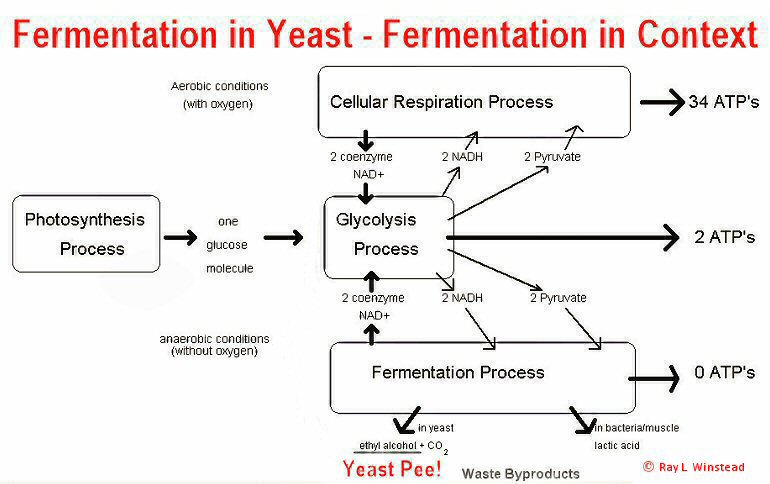In general, the process of FERMENTATION is an important part of an overall process of generating usable energy for work in the cell under anaerobic conditions (i.e., when no oxygen is present). Yeast cells use glucose sugar found in fruit juice and grain as an important nutrient. Plants produce the glucose sugar through the process of PHOTOSYNTHESIS. This sugar is the basic energy supply for cells, however glucose is a form of energy not easily used to power chemical reactions. The glucose must first of all be transformed into a more usable form. An analogy would be the energy in coal being transformed into electricity. The energy in coal can not be used easily to power a radio or other appliance, but electricity is a usable form of energy that can be used in many different ways. The same situation arises for glucose - corresponding to the coal - as an initial source of stored energy for the cell. Glucose is transformed into adenosine triphosphate - ATP, which is an energy source that easily powers other chemical reactions within the cell. For example, for any chemical X reacting with another chemical Y to produce a useful product chemical Z, plus waste byproducts, energy is needed to "drive" the chemical reaction forward. Furthermore, a protein enzyme is needed to act as a catalyst to control the rate of the chemical reaction. ATP consists of 3 phosphate groups: Adenosine + Phosphate + Phosphate + Phosphate. Energy is in the bonds holding the molecules together and energy is released when a phosphate group splits off to form ADP (Adenosine diphosphate). See figure 1 below:

Figure 1
In some chemical reactions an extra COENZYME is necessary, because the coenzyme is essential for the activity of the enzyme. For example, vitamins are often converted into coenzymes. One coenzyme that is important in the transformation of glucose to ATP is NAD+, i.e., nicotinamide adenine dinucleotide. Coenzymes are always changed in some way in the reaction. Therefore their original form must be restored by other reactions before they can function again. In particular, NAD+ is loosely bound to enzymes and serves as an energy intermediate in the synthesis of ATP and is changed into the reduced form NADH in the process.
The starting point in the process of converting glucose to ATP is the process of GLYCOLYSIS that initially breaks down glucose. Glycolysis incorporates a series of steps that both generates a small amount of ATP and also produces chemicals to be used further in the process of either fermentation or cellular respiration. The glycolysis process also produces pyruvate as it breaks down glucose. See figure 2 below:

Figure 2: Fermentation in Yeast - Fermentation in
Context
The MAIN FUNCTION OF FERMENTATION is to regenerate the coenzyme NAD+, so that the glycolysis process can continue to breakdown glucose, produce ATP, and also produce pyruvate for the continuation of the process at the same time in anaerobic conditions when no oxygen is available. For example, bacteria and yeast cells living in anaerobic conditions use the combination of glycolysis and fermentation to continue to produce ATP. Likewise animal muscle cells can use pyruvate in a fermentation process to continue to make ATP as a backup process under stress in anaerobic conditions, e.g., when the oxygen needed can not be delivered fast enough. Muscle cells are much more efficient at producing ATP using the chemical pathways in the cellular respiration process when enough oxygen is available.
In addition to transforming NADH back to the usable coenzyme NAD+ fermentation produces waste byproducts lactate or ethyl alcohol (yeast pee!) depending upon the type of cells involved. If the cells are certain types of bacteria or muscle cells the waste byproduct of lactate is produced. The accumulation of lactate produced by anaerobic bacteria in food inhibits aerobic bacteria from spoiling the food, i.e., the food is preserved and tastes different, e.g., the formation of sauerkraut when anaerobic bacteria are added to cabbage, and the formation of yogurt when anaerobic bacteria are added to milk. The accumulation of lactate produced by muscle cells in anaerobic conditions, e.g., in exercise demanding more oxygen than is available, causes the muscle soreness and muscle cramps associated with such activity. However, if the cells undergoing fermentation are yeast cells, then the waste byproduct is not lactate but ethyl alcohol (yeast pee!), e.g., the formation of wine from fruit juices when yeast cells are added to fruit juice or the formation of beer when yeast cells are added to grains (primarily barley). Fermentation does not produce any more ATP molecules but regenerates the NAD+ used up in glycolysis that does produce the needed ATP.
The cells of multicellular plants and animals consume large amount of ATP - much more than they could produce by means of the combination of glycolysis and fermentation. For example, the equivalent of about 90 pounds (!) of ATP is needed, broken down, and used by a Human body each day. We could not produce that much ATP from scratch as we needed it. The ADP is regularly transformed back into ATP with the addition of a phosphate group. The large amounts of ATP required are produced through the process of cellular respiration, which is an efficient producer of ATP from glucose by using oxygen in the process. In comparison to only 2 ATP molecules produced by the combination of glycolysis and fermentation without the presence of oxygen, 36 ATP molecules are produced by the combination of glycolysis and cellular respiration from one molecule of glucose in skeletal muscle cells and brain cells, while 38 molecules are produced in other cells.
| Front Page |
Dr. Winstead's Blood Pressure Tracker: Free Templates for Graphing Blood Pressure in Microsoft Excel
Dr. Winstead's Current Local and World Standard Percentage Metric Time Clock